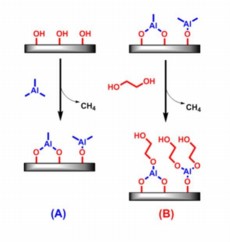Home > Press > Molecular Layer Deposition: building hybrid materials one layer at at time
 |
| http://doi.wiley.com/10.1002/adfm.201200370|Link to the original paper on Wiley Online Library: |
Abstract:
As the applications of nanotechnology grow more sophisticated, the controlled deposition of exceedingly thin layers of materials becomes of ever growing importance. A well-known technique called atomic layer deposition (ALD) can meet this challenge quite well for the deposition of thin inorganic oxide films.
Molecular Layer Deposition: building hybrid materials one layer at at time
Germany | Posted on September 13th, 2012Using this method, films can be deposited one atomic layer at a time, as if meticulously built up by a nanometer-sized bricklayer. Each deposition step uses a metal-organic precursor, and the remaining organic ligands are subsequently burnt off leaving only the inorganic film as well as preparing the surface for the next deposition step.
In its traditional method of application, it would seem that there is no chance to incorporate organic components into such films with ALD. However, Professor Steven George and co-workers have written a short review on an emerging technique called Molecular Layer Deposition (MLD), where hybrid materials can be fabricated using an adaption of conventional ALD. This new method promises open up a whole new array of possibilities for surface scientists, by adding a new degree of flexibility to thin film preparation.
In its most common form, MLD can be used to make self-limiting, conformal, pinhole-free films of metal-organic materials called metalcones. The first example of this sort was the synthesis of "alucones" (aluminum-containing metalcones) from trimethylaluminum and ethylene glycol, as illustrated in the accompanying image above. Based upon this methodology, there is a great deal of flexibility for altering the metal as well as the organic ligand in order to fabricate hybrid thin films with customized properties. By mixing the precursors for oxide growth using ALD with those used for MLD, one can also tune the degree of incorporation of the organic component in the films.
Using this method, researchers have already tuned the elastic modulus of thin films for mechanical applications, the refractive index for optical applications, and the electrical conductivity for electronic applications. All of this means that one can tailor the properties of a surface coating "made to order". The films can then be used as is, or the organic component can alternatively be burnt off to create a material with tailored porosity for applications such as catalysis. With such a degree of tunability, the possibilities are virtually endless, as Molecular Layer Deposition helps to change the face of nanomaterials, one layer at a time.
####
For more information, please click here
Copyright © Wiley-VCH Materials Science Journals
If you have a comment, please Contact us.Issuers of news releases, not 7th Wave, Inc. or Nanotechnology Now, are solely responsible for the accuracy of the content.
| Related News Press |
News and information
![]() Simulating magnetization in a Heisenberg quantum spin chain April 5th, 2024
Simulating magnetization in a Heisenberg quantum spin chain April 5th, 2024
![]() NRL charters Navy’s quantum inertial navigation path to reduce drift April 5th, 2024
NRL charters Navy’s quantum inertial navigation path to reduce drift April 5th, 2024
![]() Discovery points path to flash-like memory for storing qubits: Rice find could hasten development of nonvolatile quantum memory April 5th, 2024
Discovery points path to flash-like memory for storing qubits: Rice find could hasten development of nonvolatile quantum memory April 5th, 2024
![]() Good as gold - improving infectious disease testing with gold nanoparticles April 5th, 2024
Good as gold - improving infectious disease testing with gold nanoparticles April 5th, 2024
Thin films
![]() Utilizing palladium for addressing contact issues of buried oxide thin film transistors April 5th, 2024
Utilizing palladium for addressing contact issues of buried oxide thin film transistors April 5th, 2024
Chemistry
![]() What heat can tell us about battery chemistry: using the Peltier effect to study lithium-ion cells March 8th, 2024
What heat can tell us about battery chemistry: using the Peltier effect to study lithium-ion cells March 8th, 2024
![]() Nanoscale CL thermometry with lanthanide-doped heavy-metal oxide in TEM March 8th, 2024
Nanoscale CL thermometry with lanthanide-doped heavy-metal oxide in TEM March 8th, 2024
Discoveries
![]() Chemical reactions can scramble quantum information as well as black holes April 5th, 2024
Chemical reactions can scramble quantum information as well as black holes April 5th, 2024
![]() New micromaterial releases nanoparticles that selectively destroy cancer cells April 5th, 2024
New micromaterial releases nanoparticles that selectively destroy cancer cells April 5th, 2024
![]() Utilizing palladium for addressing contact issues of buried oxide thin film transistors April 5th, 2024
Utilizing palladium for addressing contact issues of buried oxide thin film transistors April 5th, 2024
Materials/Metamaterials/Magnetoresistance
![]() Nanoscale CL thermometry with lanthanide-doped heavy-metal oxide in TEM March 8th, 2024
Nanoscale CL thermometry with lanthanide-doped heavy-metal oxide in TEM March 8th, 2024
![]() Focused ion beam technology: A single tool for a wide range of applications January 12th, 2024
Focused ion beam technology: A single tool for a wide range of applications January 12th, 2024
Announcements
![]() NRL charters Navy’s quantum inertial navigation path to reduce drift April 5th, 2024
NRL charters Navy’s quantum inertial navigation path to reduce drift April 5th, 2024
![]() Discovery points path to flash-like memory for storing qubits: Rice find could hasten development of nonvolatile quantum memory April 5th, 2024
Discovery points path to flash-like memory for storing qubits: Rice find could hasten development of nonvolatile quantum memory April 5th, 2024
|
|
||
|
|
||
| The latest news from around the world, FREE | ||
|
|
||
|
|
||
| Premium Products | ||
|
|
||
|
Only the news you want to read!
Learn More |
||
|
|
||
|
Full-service, expert consulting
Learn More |
||
|
|
||








